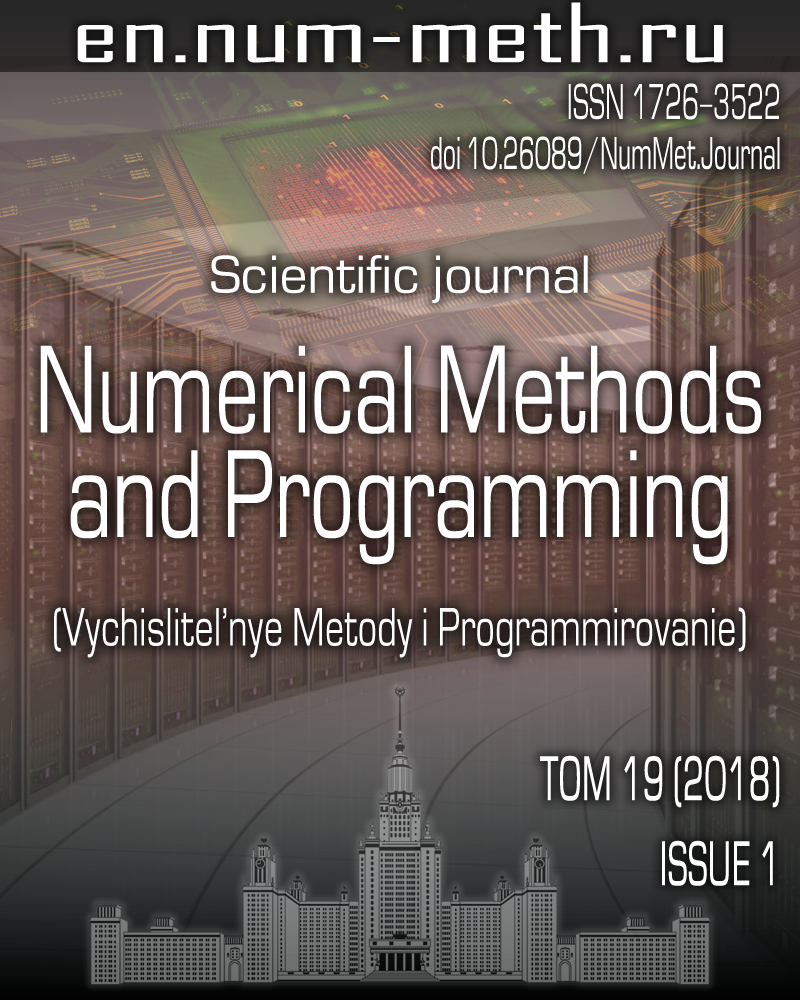DOI: https://doi.org/10.26089/NumMet.v19r107
An algorithmic chain for the forward personalized ECG simulation and the evaluation of its working time
Keywords:
segmentation of medical images
personalized models
texture analysis
forward ECG simulation
Abstract
An algorithmic chain for the forward ECG simulation using personalized anatomical patient models is proposed. The proposed algorithmic chain contains algorithms for segmentation of medical images, mesh generation and solving the forward ECG problem. The algorithms for segmentation and solving the forward ECG problem are accelerated. The working time of the algorithmic chain is evaluated.
Published
2018-02-25
Issue
Section
Section 1. Numerical methods and applications
References
- L. Rineau and M. Yvinec, “A Generic Software Design for Delaunay Refinement Meshing,” Comp. Geom. Theory Appl. 38 (1-2), 100-110 (2007).
- Yu. V. Vasilevskii, A. A. Danilov, K. N. Lipnikov, and V. N. Chugunov, Automatized Technologies for Constructing Unstructured Computational Grids (Fizmatlit, Moscow, 2016) [in Russian].
- CGAL 4.11 - 3D Mesh Generation, User Manual.
https://doc.cgal.org/latest/Mesh_3/index.html . Cited February 13, 2018. - Advanced Numerical Instruments 3D.
https://sourceforge.net/projects/ani3d . Cited February 13, 2018. - J. Sundnes, B. F. Nielsen, K. A. Mardal, et al., “On the Computational Complexity of the Bidomain and the Monodomain Models of Electrophysiology,” Ann. Biomed. Eng. 34 (7), 1088-1097 (2006).
- F. B. Sachse, M. Wolf, C. Werner, and K. Meyer-Waarden, “Extension of Anatomical Models of the Human Body: Three-Dimensional Interpolation of Muscle Fiber Orientation Based on Restrictions,” J. Comput. Inf. Techn. 6 (1), 95-101 (1998).
- A. V. Strutynsky, Electrocardiogram: Analysis and Interpretation (MEDPress-inform, Moscow, 2012) [in Russian].
- R. C. Gonzalez and R. E. Woods, Digital Image Processing (Prentice-Hall, Upper Saddle River, 2006).
- A. Buades, B. Coll, and J.-M. Morel, “A Non-Local Algorithm for Image Denoising,” in Proc. 2005 IEEE Conf. on Computer Vision and Pattern Recognition, San Diego, USA, June 20-25, 2005 (IEEE Press, Washington, DC, 2005), Vol. 2, pp. 60-65.
- A. Buades, B. Coll, and J.-M. Morel, “Non-Local Means Denoising,” Image Processing On Line 1, 208-212 (2011).
doi 10.5201/ipol.2011.bcm_nlm - Amira for Life Sciences. 3D Visualization and Analysis Software.
https://www.fei.com/software/amira-3d-for-life-sciences/. Cited February 13, 2018. - gputools - OpenCL Accelerated Volume Processing in Python.
https://github.com/maweigert/gputools . Cited February 13, 2018. - R. M. Haralick, K. Shanmugam, and I. Dinstein, “Textural Features for Image Classification,” IEEE Trans. Syst. Man Cybern. SMC-3} (6), 610-621 (1973).
- ITK-SNAP.
http://www.itksnap.org . Cited February 13, 2018. - Convert3D Medical Image Processing Tool.
https://sourceforge.net/projects/c3d . Cited February 13, 2018. - P. A. Yushkevich, J. Piven, H. C. Hazlett, et al., “User-Guided 3D Active Contour Segmentation of Anatomical Structures: Significantly Improved Efficiency and Reliability,” Neuroimage 31 (3), 1116-1128 (2006).
- A. Danilov, R. Pryamonosov, and A. Yurova, “Image Segmentation for Cardiovascular Biomedical Applications at Different Scales,” Computation 4 (3) (2016).
doi 10.3390/computation4030035 - R. E. Mason and I. Likar, “A New System of Multiple-Lead Exercise Electrocardiography,” Am. Heart J. 71 (2), 196-205 (1966).
- D. U. J. Keller, F. M. Weber, G. Seemann, and O. Dössel, “Ranking the Influence of Tissue Conductivities on Forward-Calculated ECGs,” IEEE Trans. Biomed. Eng. 57 (7), 1568-1576 (2010).
- M. Hofer, CT Teaching Manual (Georg Thieme Verlag, Stuttgart, 2007; Meditsinskaya Literatura, Moscow, 2008).
- N. Zemzemi, M. O. Bernabeu, J. Saiz, et al., “Computational Assessment of Drug-Induced Effects on the Electrocardiogram: from Ion Channel to Body Surface Potentials,” Br. J. Pharmacol. 168 (3), 718-733 (2013).
- F. M. Weber, D. U. J. Keller, S. Bauer, et al., “Predicting Tissue Conductivity Influences on Body Surface Potentials - An Efficient Approach Based on Principal Component Analysis,” IEEE Trans. Biomed. Eng. 58 (2), 265-273 (2011).
- B. F. Nielsen, M. Lysaker, and P. Grøttum, “Computing Ischemic Regions in the Heart with the Bidomain Model - First Steps Towards Validation,” IEEE Trans. Med. Imaging 32 (6), 1085-1096 (2013).

